The Stepford Wives
Frank Oz’s The Stepford Wives is a modern re-interpretation of the 1975 science fiction film and 1972 novel written by Ira Levin, all of the same name. The now classic story of an affluent American town in which the perfect housewives who inhabit it are really robots created by the men of Stepford has become so widespread since its publication that it has entered and imbedded the realms of popular culture. The phrase “Stepford Wife” has become a common reference and part of the modern lexicon, operating as shorthand for the unachievable  ideal of the perfect housewife. Bryan Forbes’ The Stepford Wives was released only three years after Levin’s novel was published. They are both set in the mid 1970s, (amidst the women’s liberation movement) so they both tackle the tensions feminist movements generated within the nation during the time. This updated version transfers the plot from the time of the 1970s to the 21st century. Modern social standards and consequences have been introduced to the plot and significant changes have been made for contemporary audiences. What was once sharp social commentary on the patriarchal fear of the feminist movement and the female anger this paranoia incited has been transformed into a campy satire of a present-day gender struggles.
ideal of the perfect housewife. Bryan Forbes’ The Stepford Wives was released only three years after Levin’s novel was published. They are both set in the mid 1970s, (amidst the women’s liberation movement) so they both tackle the tensions feminist movements generated within the nation during the time. This updated version transfers the plot from the time of the 1970s to the 21st century. Modern social standards and consequences have been introduced to the plot and significant changes have been made for contemporary audiences. What was once sharp social commentary on the patriarchal fear of the feminist movement and the female anger this paranoia incited has been transformed into a campy satire of a present-day gender struggles.
Forbes’ film was met with lukewarm enthusiasm at the box office and mixed critical reviews. Betty Friedman, author of The Feminine Mystique, whose work certainly informs the feminist drive of the film, called the film a “rip-off” of the women’s liberation movement. Many critics panned the films seemingly simplistic interpretation of the feminist movement and its negative portrayal of men, as sociologist Herbert Gans stated, “The film sees the women’s movement as setting women against men, thus ignoring the many feminists who have argued that women’s liberation cannot be achieved without larger social change that also liberates men.”[1] The Village Voice critic Molly Haskell expresses a similar sentiment when she discussed  the film describing the film as “a comical slander of men in general and of the Connecticut branch of the breed in particular”; while Pauline Kael argued that the film “hits men below the belt.”[2] Although most critics viewed the film as unsuccessful, David Bartholomew praised the film stating that, “The Stepford Wives is probably the only viable, intelligently conceived movie about women and their future made in the past decade…(it) is one of the select few genre films more important for its ideas than its genre excitements.”[3] Bonnie J. Dow challenges the notion that the film’s negative treatment of the Stepford men is a flaw by arguing, “What is lost here is that patriarchy is presented as a system in The Stepford Wives, not as a battle between individual men and individual women… The commitment of the film to avoiding personal motives is perfectly demonstrated by the presence of the Stepford Men’s Association as the embodiment of institutionalized patriarchy. Men, as a group, oppress women, as a group, because they can, because it benefits them.”[4]
the film describing the film as “a comical slander of men in general and of the Connecticut branch of the breed in particular”; while Pauline Kael argued that the film “hits men below the belt.”[2] Although most critics viewed the film as unsuccessful, David Bartholomew praised the film stating that, “The Stepford Wives is probably the only viable, intelligently conceived movie about women and their future made in the past decade…(it) is one of the select few genre films more important for its ideas than its genre excitements.”[3] Bonnie J. Dow challenges the notion that the film’s negative treatment of the Stepford men is a flaw by arguing, “What is lost here is that patriarchy is presented as a system in The Stepford Wives, not as a battle between individual men and individual women… The commitment of the film to avoiding personal motives is perfectly demonstrated by the presence of the Stepford Men’s Association as the embodiment of institutionalized patriarchy. Men, as a group, oppress women, as a group, because they can, because it benefits them.”[4]
The social implications of feminist struggle have certainly changed and evolved since the 1970s, so in order to tell the story in which men are driven into transforming their wives into subservient robots, a significant shift in tone and narrative was implemented. While the first film challenged patriarchal attitudes towards women, and incorporated basic feminist tenets popularized at the time, the 2004 remake’s plot is motivated by a desire to turn back the clock and adhere to traditional and archaic gender norms. The mastermind behind the Stepford project in Oz’s film longs for the time before women’s liberation, when women’s place was in the home, the domestic sphere. The men in Forbes’ film are the original oppressors of women, reacting to the relatively new feminist movement.
Since the idea that feminism as a social threat can no longer work as a viable premise for a modern film and cannot really be taken seriously, (society has progressed a significant amount in the past four decades and women are equally present in the workforce) the men are not threatened by their spouses’ interest in the feminist movement, but instead feel emasculated by their partners’ successes in their professional lives. The women become Stepford Wives by being molded into the image of the quintessential 1950s housewife.
The 2004 film introduces us to Joanna Eberhart, a ruthless television executive who has been abruptly fired from her job, she consequently tailspins into a nervous breakdown and is admitted briefly in a hospital. Joanna is remorseful of her intense ambition and feels that she has neglected her wifely duties, so she suggests her family leaves the city to make up for it. Soon after Joanna, her husband Walter and their two children move to Stepford. It doesn’t take long for Joanna to find the people of Stepford a bit peculiar and she becomes suspicious of their strange behavior.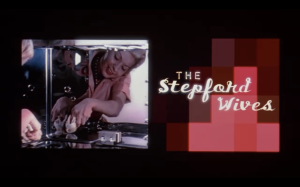
The film opens with a montage of vintage 50s era commercials of beautiful women, impeccably dressed showcasing all kinds of household appliances, ovens, toasters, refrigerators, etc. This immediately sets up, not only the campy tone of the film, but also the ideal of the 50s housewife. Paul Rudnick, in an interview for the film, discusses the look of the wives, “…from the early days of planning on Stepford Wives we were discussing the wives themselves would wear, what the look and the aura would be. We had this genius costume designer, Ann Roth, and there was this sense that if you pushed it too far in the male-fantasy direction, they’d become hookers, they’d become showgirls. There was something more Connecticut and suburban that we were after.”[5] The decision to pattern the women after the ideal 50s housewife permits the men to feel power over them; there is nothing to be threatened by after the women’s transformation. The men’s actions are driven by their fear and anxiety of being overpowered and losing control of the authority they have held over women for so many years. If the women were characterized as sex-bombs and overtly sexualized to address male lustful fantasies, they could have become more threatening to the men of Stepford. There is something intimidating about a woman flaunting her sexuality, which implies a rejection of patriarchal pressures and it is the exact opposite of the submissive archetype these men want to control.
The attempt to update the now classic story to a more modern and relatable milieu could have produced a great film of smart social satire, but unfortunately the many, many plot inconsistencies, clunky writing, and some questionable performances prevent it from ever becoming that. Oz embraces the high camp characteristics from the original film and by doing that the sense of eeriness and threat that permeates the 1975 film is almost completely eradicated. One thing that was so great about that original film is the insidious and sinister nature of the Stepford men and their whole master plan; Dale Coba and the Men’s Association were truly scary and imposed a real threat upon the Stepford women. Despite the very real tension created by the film’s opposing forces, there is still a sense of satire and parody present, which adds levity to the tense narrative. I mean, Joanna is ultimately thwarted and strangled with some damn pantyhose, the sartorial symbol of working women of the day, that’s pretty hilarious. Moments like this could be seen an inadvertently campy, but the satiric nature of the story allows these moments to occur and still maintain a foreboding mood.
The 2004 film gets a little too wacky and ‘sitcom-y’ with hackneyed jokes and over the top performances. The screenwriter hits us over the head with so many quips and snarky lines; it like he’s screaming at us, “Hey, aren’t I the cleverest writer ever? Laugh at my bitchy jokes!” It gets old fast and what we are left with is a shallow story about juvenile men who can’t stand their partners’ successes. Which is a shame because the cast is absolutely superb. Nicole Kidman, Glen Close, Christopher fucking Walken! It’s frustrating to see actors that we know can be very good, who can execute good material, and then have to see them in this plot hole laden mess. One of the few redeeming parts of the film are some of the performances, certain moments when the actors shine, regardless of the thinness of the narrative. Joanna’s reaction as she realizes she has been fired from her fancy TV job, the emotionally convincing scene between Walter and Joanna at the Men’s Association, Glen Close’s meltdown at the very end of the movie, etc. Another redeeming quality is how the film looks; the creation of the Stepford world is pulled off expertly. The town of Stepford is both pleasant and familiar, while slightly off. The production design is great and, of course, so are the costumes.
Roth’s costume designs communicate the contrast between the Stepford Wives and the not yet transformed women, which is an important part of the narrative and a main concern that drives Joanna’s actions. It is an important visual element of the film, the way the women are dressed instantly communicates to the audience  whether or not they have been transformed into subservient robots. When we see Bobbi Markowitz the first time after her transformation her appearance tells us that she is now a Stepford Wife, the retro 1950s look she wears is so blatantly different from her previous way of dressing that we, along with Joanna, know immediately that she is transformed. Her over the top behavior only confirms what we have already devised.
whether or not they have been transformed into subservient robots. When we see Bobbi Markowitz the first time after her transformation her appearance tells us that she is now a Stepford Wife, the retro 1950s look she wears is so blatantly different from her previous way of dressing that we, along with Joanna, know immediately that she is transformed. Her over the top behavior only confirms what we have already devised.
 Joanna’s wardrobe goes through a significant transition or evolution throughout the film. When we first meet her, she is clad in a very severe outfit. She wears a long-sleeved, slim fitting black top with a high collar, and a grey A-line skirt with a little flare that hits below the knee. Her appearance informs Joanna’s identity as a serious woman, everything is very controlled; there is not even a hair out of place, which suggests her personality is very rigid and even cold. There is no warmth in her appearance, and as she presents her line up of sleazy reality shows we find it difficult to like her. She is not the most sympathetic character when we initially meet her, even
Joanna’s wardrobe goes through a significant transition or evolution throughout the film. When we first meet her, she is clad in a very severe outfit. She wears a long-sleeved, slim fitting black top with a high collar, and a grey A-line skirt with a little flare that hits below the knee. Her appearance informs Joanna’s identity as a serious woman, everything is very controlled; there is not even a hair out of place, which suggests her personality is very rigid and even cold. There is no warmth in her appearance, and as she presents her line up of sleazy reality shows we find it difficult to like her. She is not the most sympathetic character when we initially meet her, even 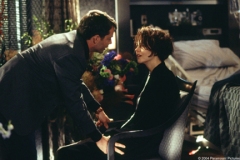 though she is our protagonist. This unflattering and over the top portrayal of Joanna fits in with the film’s satirical tone; it critiques the industry of reality television and Kidman’s almost manic delivery takes a comic turn. Although Joanna’s portrayal has not been the most flattering, her sudden firing makes us sympathize with her. Her subsequent breakdown, accompanied by her disheveled appearance, make her seem quite pitiful and instead of really identifying with her, we mostly feel sorry for her.
though she is our protagonist. This unflattering and over the top portrayal of Joanna fits in with the film’s satirical tone; it critiques the industry of reality television and Kidman’s almost manic delivery takes a comic turn. Although Joanna’s portrayal has not been the most flattering, her sudden firing makes us sympathize with her. Her subsequent breakdown, accompanied by her disheveled appearance, make her seem quite pitiful and instead of really identifying with her, we mostly feel sorry for her.
 In the hospital she is dressed in a grey t-shirt and a black robe, this color palette remains during her first days in Stepford. The first day the family arrives she is wearing a black shirt a long grey scarf, grey pants and dark sunglasses, her attire not only provides a great visual contrast to the town of Stepford, but also hints at her current state of mind. This contrast is emphasized when Mrs. Wellington takes
In the hospital she is dressed in a grey t-shirt and a black robe, this color palette remains during her first days in Stepford. The first day the family arrives she is wearing a black shirt a long grey scarf, grey pants and dark sunglasses, her attire not only provides a great visual contrast to the town of Stepford, but also hints at her current state of mind. This contrast is emphasized when Mrs. Wellington takes  Joanna on a tour of the community. Mrs. Wellington takes Joanna to the “Simply Stepford Day Spa” where the women of Stepford spend their leisurely time; it is here that Joanna meets a group of the wives for the first time. As Mrs. Wellington opens the doors to an expansive room, several women huddle in the middle of the room, “Good morning, ladies,” says Mrs. Wellington. The women move delicately to acknowledge Mrs. Wellington and in delicate, and soft voices they all respond eerily in unison, “Good morning, Claire.” The women are all clad in dresses that hit bellow the knees, high heels and have perfectly styled hair. Their dresses all seem to be variations of floral prints, in an array of bright and feminine colors. Joanna, on the other hand wears black pants, a long sleeved black shirt and a grey sweater draped around her neck.
Joanna on a tour of the community. Mrs. Wellington takes Joanna to the “Simply Stepford Day Spa” where the women of Stepford spend their leisurely time; it is here that Joanna meets a group of the wives for the first time. As Mrs. Wellington opens the doors to an expansive room, several women huddle in the middle of the room, “Good morning, ladies,” says Mrs. Wellington. The women move delicately to acknowledge Mrs. Wellington and in delicate, and soft voices they all respond eerily in unison, “Good morning, Claire.” The women are all clad in dresses that hit bellow the knees, high heels and have perfectly styled hair. Their dresses all seem to be variations of floral prints, in an array of bright and feminine colors. Joanna, on the other hand wears black pants, a long sleeved black shirt and a grey sweater draped around her neck.
 The black, sleeveless, form fitting dress Joanna wears for a community event, again visually reinforces the divide between her and the Stepford Wives as well as the rest of the community. Most of the people in the picnic are dressed in soft colors, pastels, and the women wear fuller dresses with less severe silhouettes. Joanna stands out as a dark spot in a sea of colorful pastels.
The black, sleeveless, form fitting dress Joanna wears for a community event, again visually reinforces the divide between her and the Stepford Wives as well as the rest of the community. Most of the people in the picnic are dressed in soft colors, pastels, and the women wear fuller dresses with less severe silhouettes. Joanna stands out as a dark spot in a sea of colorful pastels.
As Joanna begins to integrate to the community and attempts to fit a more ideal version of what a wife should be, her wardrobe changes drastically. Gone are the dreary blacks and greys that were so prevalent in her attire, they are replaced by colorful items in pretty pastels, ranging from lilacs, and pale yellows to soft pinks and baby blues. The first time we see her attempting the “Stepford look”, she wears a pink short-sleeved dress, a floral printed apron and her hair is adorned with a pink bow headband. She is in the domestic realm, working in the kitchen and cleaning the house. Her physical transformation occurs simultaneously with her behavioral shift, which implies that in Stepford the physical attributes and the way the women compose themselves are equally important. The ideal of the housewife is only met when these two qualities are fulfilled to their highest potential. The film critiques this notion of domesticity by emphasizing the women’s impeccable appearances. There is really no need for a woman to be beautiful or dress splendidly to be a good housewife, or vise versa, but for the men of Stepford it is absolutely crucial that the ladies meet both standards.
be, her wardrobe changes drastically. Gone are the dreary blacks and greys that were so prevalent in her attire, they are replaced by colorful items in pretty pastels, ranging from lilacs, and pale yellows to soft pinks and baby blues. The first time we see her attempting the “Stepford look”, she wears a pink short-sleeved dress, a floral printed apron and her hair is adorned with a pink bow headband. She is in the domestic realm, working in the kitchen and cleaning the house. Her physical transformation occurs simultaneously with her behavioral shift, which implies that in Stepford the physical attributes and the way the women compose themselves are equally important. The ideal of the housewife is only met when these two qualities are fulfilled to their highest potential. The film critiques this notion of domesticity by emphasizing the women’s impeccable appearances. There is really no need for a woman to be beautiful or dress splendidly to be a good housewife, or vise versa, but for the men of Stepford it is absolutely crucial that the ladies meet both standards.
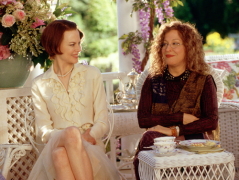 On her first Stepford outing since her self imposed makeover, Joanna attends a book club with the rest of the Stepford women. She is dressed in a delicate pale yellow ruffled blouse and matching skirt, accented with a classic pearl necklace. The clothes soften her previously severe and rigid appearance. Joanna almost fits the bill of a Stepford Wife, of course her demeanor and general behavior contrasts with the eerily cheerful Stepford Wives, but there is also an element that visually distinguishes Joanna from the rest of the ladies. The “real” Stepford wives are all wearing wide brimmed hats that
On her first Stepford outing since her self imposed makeover, Joanna attends a book club with the rest of the Stepford women. She is dressed in a delicate pale yellow ruffled blouse and matching skirt, accented with a classic pearl necklace. The clothes soften her previously severe and rigid appearance. Joanna almost fits the bill of a Stepford Wife, of course her demeanor and general behavior contrasts with the eerily cheerful Stepford Wives, but there is also an element that visually distinguishes Joanna from the rest of the ladies. The “real” Stepford wives are all wearing wide brimmed hats that  coordinate with their day outfits. This is a subtle detail that draws attention to Joanna’s otherness in a visual way, were it not for that element, Joanna would have filled the look of the Stepford Wife.
coordinate with their day outfits. This is a subtle detail that draws attention to Joanna’s otherness in a visual way, were it not for that element, Joanna would have filled the look of the Stepford Wife.
Joanna’s otherness is eventually thwarted towards the climax of the film. We are led to believe that she has been transformed into another Stepford Wife. After being led into the Men’s Association, Joanna and Walter descend into a private chamber where her transformation will take place. The scene that follows is set in a supermarket, where the many Stepford Wives glide serenely through the aisles as they gather their groceries. The camera moves through the market, slowly tracking and panning, capturing the women’s smooth movements until a still shot showing an empty aisle appears. We see Joanna turn into the aisle with the same serene walk and empty stare as all the others before her. She wears a floral print dress in soft colors with a tight bodice and tiered skirt in a light and airy fabric. Her short auburn hair is now shoulder length and light blonde. We believe she has been transformed because for the first time in the film her appearance and behavior correlate with what a Stepford Wife is. She carries herself daintily and appears to be almost devoid of any trace of personality, she is no longer herself.
moves through the market, slowly tracking and panning, capturing the women’s smooth movements until a still shot showing an empty aisle appears. We see Joanna turn into the aisle with the same serene walk and empty stare as all the others before her. She wears a floral print dress in soft colors with a tight bodice and tiered skirt in a light and airy fabric. Her short auburn hair is now shoulder length and light blonde. We believe she has been transformed because for the first time in the film her appearance and behavior correlate with what a Stepford Wife is. She carries herself daintily and appears to be almost devoid of any trace of personality, she is no longer herself.
We eventually learn that she has not been brainwashed and was just pretending to be a Stepford Wife in order to reverse the actions of the town’s husbands. Walter and Joanna are successful in their attempt to free the women from their husbands’ control and uncover that the mastermind behind the entire scheme was not Mike Wellington, but his wife Claire, and that Mike was a robot controlled by her. In the film’s epilogue we see Joanna, Bobbi, and Roger as guests on Larry King Live where they discuss their experiences in Stepford. Joanna, instead of reverting to her initial style of clothing, is wearing a burgundy colored blazer with strong 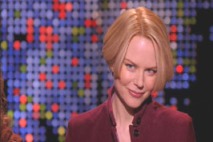 shoulder, underneath peeks a delicate lilac colored blouse and her hair, although cut back to the short bob she sported in he beginning, remains a light blonde color. Joanna’s appearance six months after her ordeal in Stepford implies that she has indeed softened and tempered her rigid personality and way of life, but has not changed completely. Her appearance suggests that she has reached a happy medium between the controlling woman she once was and the unsettling perfection of a Stepford wife. She wears a bright, but serious color, the blazer is structured and is similar to the one we first see her in in the television showcase, her hair seems to be the same haircut, but it is not as contained as it is when we first see her. Her hair is lighter as previously mentioned, but it is also looser and has more volume giving her a more feminine and delicate look. Ultimately, the film asserts that there is indeed some kind of ideal that should be met. Joanna’s new, new look is a composite of both the Stepford ideal and her bleak appearance from the beginning, she is now the epitome of the 21st century woman, a successful professional as well as doting wife.
shoulder, underneath peeks a delicate lilac colored blouse and her hair, although cut back to the short bob she sported in he beginning, remains a light blonde color. Joanna’s appearance six months after her ordeal in Stepford implies that she has indeed softened and tempered her rigid personality and way of life, but has not changed completely. Her appearance suggests that she has reached a happy medium between the controlling woman she once was and the unsettling perfection of a Stepford wife. She wears a bright, but serious color, the blazer is structured and is similar to the one we first see her in in the television showcase, her hair seems to be the same haircut, but it is not as contained as it is when we first see her. Her hair is lighter as previously mentioned, but it is also looser and has more volume giving her a more feminine and delicate look. Ultimately, the film asserts that there is indeed some kind of ideal that should be met. Joanna’s new, new look is a composite of both the Stepford ideal and her bleak appearance from the beginning, she is now the epitome of the 21st century woman, a successful professional as well as doting wife.
 Joanna’s wardrobe and appearance is not the only one that goes through a series of changes and shifts. There are specific moments in which Walter’s clothing informs something significant for the character. In Stepford picnic Walter attends with Joanna he wears a pair of khakis that a group of women compliment him on, he responds with “They’re new, a little experiment.” This “new experiment” arises right after he attends the Men’s Association for the first time; the previous scene shows
Joanna’s wardrobe and appearance is not the only one that goes through a series of changes and shifts. There are specific moments in which Walter’s clothing informs something significant for the character. In Stepford picnic Walter attends with Joanna he wears a pair of khakis that a group of women compliment him on, he responds with “They’re new, a little experiment.” This “new experiment” arises right after he attends the Men’s Association for the first time; the previous scene shows  Walter walking in through the club’s door. His outfit of a brightly colored polo shirt and khakis will be later be seen as a kind of Stepford uniform for the men, in a similar way in which colorful dresses are for the women. This outfit points to Walter’s interest of belonging to the men’s group and trying to fit in with the club members. We eventually see Walter as a full member of the men’s association when he wears a burgundy blazer jacket adorned with an insignia on the left-hand breast that all the men in the club wear; this is the official uniform of the association. Walter wears it only after the secret of the Stepford Wives is revealed to him, so the jacket suggests a kind of initiation into the sinister fraternity.
Walter walking in through the club’s door. His outfit of a brightly colored polo shirt and khakis will be later be seen as a kind of Stepford uniform for the men, in a similar way in which colorful dresses are for the women. This outfit points to Walter’s interest of belonging to the men’s group and trying to fit in with the club members. We eventually see Walter as a full member of the men’s association when he wears a burgundy blazer jacket adorned with an insignia on the left-hand breast that all the men in the club wear; this is the official uniform of the association. Walter wears it only after the secret of the Stepford Wives is revealed to him, so the jacket suggests a kind of initiation into the sinister fraternity.
 Bobbi Markowitz and Roger Bannister both go through the Stepford transformation, which drastically changes their wardrobe. Bobbi’s wardrobe consisted of concert t-shirts, loose fitting pants or skirts and cardigans and sweaters, the color palette was dark, blacks, dark browns, etc. her hair was curly and brown and she wore glasses. Roger, on the other hand, was a stereotypically flamboyant gay man who dressed up in designer clothes of bright colors and obnoxious
Bobbi Markowitz and Roger Bannister both go through the Stepford transformation, which drastically changes their wardrobe. Bobbi’s wardrobe consisted of concert t-shirts, loose fitting pants or skirts and cardigans and sweaters, the color palette was dark, blacks, dark browns, etc. her hair was curly and brown and she wore glasses. Roger, on the other hand, was a stereotypically flamboyant gay man who dressed up in designer clothes of bright colors and obnoxious prints. Bobbi is transformed into the quintessential Stepford Wife,
 when Joanna sees her after she has been brainwashed Bobbi wears a blue, floral printed dress with a full bellow the knee skirt, a sheer yellow apron and silver heels; her hair is now blonde and styled in an elegant bob, and her face is perfectly made up. Roger is changed drastically as well, but instead of heightening his appearance to look more put together, his look is toned down considerably in order to normalize his ostentatious style. After his transformation Roger wears a serious dark suit and red tie, nothing remarkable about his outfit to make him stand out in any way, which is what is acceptable for the meek men.
when Joanna sees her after she has been brainwashed Bobbi wears a blue, floral printed dress with a full bellow the knee skirt, a sheer yellow apron and silver heels; her hair is now blonde and styled in an elegant bob, and her face is perfectly made up. Roger is changed drastically as well, but instead of heightening his appearance to look more put together, his look is toned down considerably in order to normalize his ostentatious style. After his transformation Roger wears a serious dark suit and red tie, nothing remarkable about his outfit to make him stand out in any way, which is what is acceptable for the meek men.
 Roth successfully utilizes costume to draw distinctions between Stepford and non-Stepford people, she achieves, mostly by juxtaposing extremes and creating strong contrasts (Joanna’s black dress in the Stepford picnic), but Roth also employs subtle details and clues to communicate certain ideas to the audience. While Joanna’s attempts at dressing more like a Stepford Wife are earnest and come close to the ideal, there are particular aspects about her clothing that remind the audience of her difference. Joanna’s silhouette never really varies from the first time we see her, her clothing remains consistently fitted, without any kind of volume or
Roth successfully utilizes costume to draw distinctions between Stepford and non-Stepford people, she achieves, mostly by juxtaposing extremes and creating strong contrasts (Joanna’s black dress in the Stepford picnic), but Roth also employs subtle details and clues to communicate certain ideas to the audience. While Joanna’s attempts at dressing more like a Stepford Wife are earnest and come close to the ideal, there are particular aspects about her clothing that remind the audience of her difference. Joanna’s silhouette never really varies from the first time we see her, her clothing remains consistently fitted, without any kind of volume or  shape. This opposes the style of the Stepford Wives, who emphasize their feminine shapes and curves. It isn’t until the end when Joanna pretends to have been transformed that there is a hint of a shape and some volume in her clothing. This look is also supposed to make the audience believe she has been successfully brainwashed, so it makes sense that Roth would wait until this point to introduce this element in Joanna’s clothing. Another small detail concerning Joanna’s clothing is when she attempts to fit into the Stepford mold; her outfits would be completely monochromatic, as if she prepared each outfit by
shape. This opposes the style of the Stepford Wives, who emphasize their feminine shapes and curves. It isn’t until the end when Joanna pretends to have been transformed that there is a hint of a shape and some volume in her clothing. This look is also supposed to make the audience believe she has been successfully brainwashed, so it makes sense that Roth would wait until this point to introduce this element in Joanna’s clothing. Another small detail concerning Joanna’s clothing is when she attempts to fit into the Stepford mold; her outfits would be completely monochromatic, as if she prepared each outfit by  merely the colors, she had her yellow outfit, her pink ensemble, her purple look, etc. It seems a very simple and easy way to put together a look and suggests that this was the one way she could dress herself.
merely the colors, she had her yellow outfit, her pink ensemble, her purple look, etc. It seems a very simple and easy way to put together a look and suggests that this was the one way she could dress herself.
Roth also seems to hint clues to the audience about the characters and their identity with the use of costume. Roth seemed to be hinting at Claire Wellington’s identity as a woman, not a brainwashed Stepford Wife, early on in the film. As Claire shows Joanna around the community she wears a pair of pink and white gingham printed pants with a white button down shirt with pink trim. Her outfit is appropriate for a real 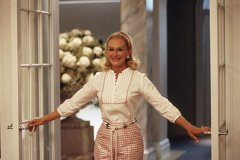 Stepford Wife, but the fact that she wears pants and not a skirt is quite significant. She, along with Joanna and Bobbi are the only women in the film seen wearing pants or trousers instead of a skirt, creating a correlation among the three characters.
Stepford Wife, but the fact that she wears pants and not a skirt is quite significant. She, along with Joanna and Bobbi are the only women in the film seen wearing pants or trousers instead of a skirt, creating a correlation among the three characters.
The blazer that Joanna wears during the last scene with Larry King draws a parallel with the jackets worn by the men in the Men’s  Association, they are similar in both color and silhouette. Joanna wearing such a similar jacket to the one the men used hints at her character regaining the power the men lost after their scheme being discovered. It is an appropriation of a symbol that represented the women’s oppression and is a clever and subtle way that Roth communicates the idea of reaffirming control.
Association, they are similar in both color and silhouette. Joanna wearing such a similar jacket to the one the men used hints at her character regaining the power the men lost after their scheme being discovered. It is an appropriation of a symbol that represented the women’s oppression and is a clever and subtle way that Roth communicates the idea of reaffirming control.
The use of clothing in the original 1975 version differs greatly from what we have seen in Frank Oz’s interpretation. The earlier version, more akin to the novel, seems less preoccupied with the specific fashions the Stepford Wives wear. There are very few direct references to the clothing the characters wear in the novel. There are several moments in the film in which the costume designs communicate certain themes and ideas. The overall image of the Stepford Wife in this film is quite different from the womanly 1950s style seen in Oz’s film. The first Stepford wife we see is Carol Van Sant she moves and talks slowly and calmly as if in a trance, she wears a long-sleeved white button down blouse, over it a strange overall skirt piece in a patchwork print, the skirt falls all the way down to her ankles and almost every inch of her body is covered. Our first introduction to a Stepford Wife is quite different from the remake, instead of being alluring and attractive, Carol lacks any kind of sex appeal and exudes a generally chaste quality.
are several moments in the film in which the costume designs communicate certain themes and ideas. The overall image of the Stepford Wife in this film is quite different from the womanly 1950s style seen in Oz’s film. The first Stepford wife we see is Carol Van Sant she moves and talks slowly and calmly as if in a trance, she wears a long-sleeved white button down blouse, over it a strange overall skirt piece in a patchwork print, the skirt falls all the way down to her ankles and almost every inch of her body is covered. Our first introduction to a Stepford Wife is quite different from the remake, instead of being alluring and attractive, Carol lacks any kind of sex appeal and exudes a generally chaste quality.
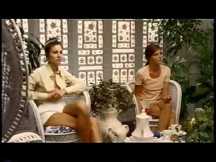 An important moment in the film that affirms this idea is when Joanna and Bobbi go around the neighborhood canvassing for women to join a “consciousness group”. As they both go from house to house they are met with the perfect Stepford Wives, in this sequence they are all clad in completely white outfits, again evoking the idea of purity and innocence. The women they go meet are also involved in housewife duties while they talk to them. They talk to a woman while she is ironing, another while
An important moment in the film that affirms this idea is when Joanna and Bobbi go around the neighborhood canvassing for women to join a “consciousness group”. As they both go from house to house they are met with the perfect Stepford Wives, in this sequence they are all clad in completely white outfits, again evoking the idea of purity and innocence. The women they go meet are also involved in housewife duties while they talk to them. They talk to a woman while she is ironing, another while  she works in the kitchen, and another while she gardens, all clad in crisp, and pristine white.
she works in the kitchen, and another while she gardens, all clad in crisp, and pristine white.
The idea of the perfect or ideal housewife in this film is quite puritanical and constricting. It takes the notion of women appearing less threatening, which I elaborated on previously, to the complete extreme. Here the men take away any kind of physical power and intrigue that the women could have. The qualities of purity and even chastity 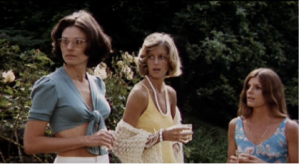 are communicated by the clothing the Stepford Wives wear. The wives are contrasted from Joanna and Bobbi because they both have their moments in which they flaunt their bodies unabashedly; both women are shown baring their midriffs at some point and exposing their legs comfortably.
are communicated by the clothing the Stepford Wives wear. The wives are contrasted from Joanna and Bobbi because they both have their moments in which they flaunt their bodies unabashedly; both women are shown baring their midriffs at some point and exposing their legs comfortably.
When Bobbie is replaced by her robot twin, she wears a high-necked, long sleeve dress abundant in ruffles, again she is almost entirely covered and stripped of any kind of sex appeal or allure. This differs greatly from the way Bobbie had dressed throughout the film, where she had sported daring outfits as stated before. We immediately notice the transformation, similarly to the shifts in the 2004 version of the story. The startling contrast of Bobbie’s appearance tells us all we need to know, we immediately know she had been transformed and that Joanna will be next.
sported daring outfits as stated before. We immediately notice the transformation, similarly to the shifts in the 2004 version of the story. The startling contrast of Bobbie’s appearance tells us all we need to know, we immediately know she had been transformed and that Joanna will be next.
When Joanna is confronted by her own double, the robot is wearing a sheer mint green cape, through which we can see her altered and “improved” body, she is slim and well endowed, it is the only time we see a “robot”  Stepford Wife in a sexualized way in this film. The sexual, uninhibited woman is reserved for the private space of the woman and her partner. Once Joanna is transformed we cut to the iconic supermarket scene, much like the one described previously. In this version the women are all clad in floor length dresses, of pale colors with gloves and wide brimmed hats. This version of the supermarket scene shows a more extreme housewife, they are awfully overdressed for grocery shopping and it is incredibly over the top.
Stepford Wife in a sexualized way in this film. The sexual, uninhibited woman is reserved for the private space of the woman and her partner. Once Joanna is transformed we cut to the iconic supermarket scene, much like the one described previously. In this version the women are all clad in floor length dresses, of pale colors with gloves and wide brimmed hats. This version of the supermarket scene shows a more extreme housewife, they are awfully overdressed for grocery shopping and it is incredibly over the top.
Levin’s novel doesn’t focus much on the clothing the characters wear; instead he gives very general descriptions of characters’ appearances. He does make some direct descriptions, like when he describes Bobbie Markowitz’s appearance as, “short and heavy-bottomed, in a blue Snoopy sweat-shirt and jean and sandals.” While the 1975 film diverts from this vision of Bobbie, Ann Roth creates a similar looking character to the one Levin describes on the page. One character whose clothing is informed by how Levin describes him in his writing is Dale Coba, who in the 2004 film is the character Mike Wellington. He is shown in both films wearing his signature turtleneck and blazer, which sets him apart from the other men of Stepford and informs his authority figure.
Roth manages to include subtle hints and clues about certain characters within the narrative, while still adhering to the conventions of the world presented; unlike the costume design in the earlier film, where the clothing functioned as more direct and straightforward characterization that enforced the simple storyline and plot. Roth managed to add nuance and finesse to the outlandish and somewhat scattered narrative.
[1] Elyce Rae Helford. “The Stepford Wives And The Gaze.” Feminist Media Studies 6.2 (2006). 146.
[2] Bonnie J. Dow “The Traffic in Men and the Fatal Attraction of Postfeminist Masculinity.” Women’s Studies in Communication 29.1 (Spring 2006). 118.
[3] Lilly A. Boruzkowski “The Stepford Wives: The Re-created Woman.” Jump Cut 32 (April 1987). 16.
[4] Bonnie J. Dow “The Traffic in Men and the Fatal Attraction of Postfeminist Masculinity.” Women’s Studies in Communication 29.1 (Spring 2006). 119.
[5] Alonso Duralde. “Welcome to Summer Camp: Nicole Kidman and Writer Paul Rudnick Talk about Remaking The Stepford Wives in an Era When “traditional Values” Are Scarier than Ever.” The Advocate (The National Gay & Lesbian Newsmagazine) 25 May 2004. 42.





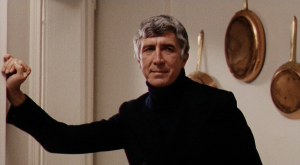

I like Stepford Wives, but the movies do over do reality. not even in all of human history has there ever been a true Stepford Wife. china didn’t even have them.